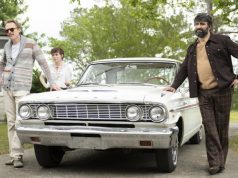No city inspires more gritty urban dramas than New York, and few cities are ever captured as authentically in movies. Lots of films create very false versions, too, of course, but when they’re accurate, they’re extremely accurate.
“A Guide to Recognizing Your Saints” joins “Manito” and “Raising Victor Vargas” as Sundance films that tell New York City coming-of-age stories so vividly that you can practically smell the urine wafting out of the subway. The tiny apartment the family lives in, the way the parents interact with each other and their children, the way the kids behave on the streets, it all feels genuine.
Dito Montiel wrote and directed the film based on his own experiences growing up in Astoria, Queens, in the 1980s, with Robert Downey Jr. playing the 2005 version of himself and Shia LaBeouf playing the 1986 version. In 1986, young Dito is a fairly typical teenager, an overall good kid slouching his way through adolescence with a small group of friends. Nerf (Peter Tambakis) is a mama’s boy at his house, while brothers Antonio (Channing Tatum) and Giuseppe (Adam Scarimbolo) suffer abuse at the hands of their father in theirs.
Dito’s parents, Monty (Chazz Palminteri) and Flori (Dianne Wiest), struggle to make ends meet in this crowded, noisy, working-class neighborhood, but they love Dito and his friends. Monty takes a particular interest in Antonio — not so much Giuseppe, who he thinks is a little crazy — and wants to give the kid a good role model.
Like most kids his age, Dito isn’t sure what he wants to do, but getting out of this go-nowhere neighborhood seems like a good start. He meets Mike O’Shea (Martin Compston), a new kid in school who just arrived from Scotland, who writes poetry and wants to start a band. Dito and Mike formulate dreams of heading West, and Dito drifts slowly away from his other friends — at just the wrong time, too, as violence among the community’s hoodlums is beginning to impact their lives.
What plot there is in the film is mostly compressed into brief spurts, allowing the rest of the movie to be a simple slice of life, meant to offer a glimpse into a specific world that is distinctly different from most people’s but that has elements of universal truth.
To that end, I can’t overstate how natural Palminteri and Wiest seem as Dito’s parents, in their costume, demeanor and dialogue. The way they age 15 years for the present-day scenes is also impressive, in the subtle ways they carry themselves with 15 additional years’ worth of heartache and worry.
Shia LaBeouf may be a little too puppyish to be a street-wise teenager, but his confidence as an actor is admirable. And as the conflicted, tragic Antonio, Channing Tatum is strikingly good, infusing the role with the passion it requires.
The film’s later scenes, with Downey as the grown-up Dito, now a noted author returning home to deal with his ailing father, aren’t as powerful as they want to be, and you could make a case for omitting the 2005 scenes altogether. But the flavor of the film is exactly right, with the humor, innocence, drama and anxiety of youth all just the way you remember them, regardless of where you grew up.
B (1 hr., 40 min.; )





